Metallogenic Chronology and Prospecting Indication of Tiechanghe Granite and Polymetallic Molybdenum Mineralization Types in Jiulong Area, Western Sichuan, China
Abstract
:1. Introduction
2. Regional Geological Background
3. Deposit Geology
3.1. Daniuchang Mo-W Deposit
3.2. Ziershi Mo-Cu Deposit
4. Sample Collection and Analytical Methods
4.1. Sample Collection and Description
4.2. Analytical Methods
4.2.1. Zircon U-Pb Geochronology
4.2.2. Molybdenite Re-Os Isotope Dating
5. Results
5.1. Zircon U-Pb Ages
5.2. Re-Os Isotope Dating of Molybdenite
6. Discussion
6.1. Implications of Zircon U-Pb and Molybdenite Re-Os Ages
6.2. Ore Formation Models and Geological Exploration Directions
7. Conclusions
Supplementary Materials
Author Contributions
Funding
Data Availability Statement
Acknowledgments
Conflicts of Interest
References
- Wu, F.Y.; Liu, X.C.; Ji, W.Q.; Wang, J.M.; Yang, L. Discussions on the petrogenesis of granites. Acta Petrol. Sin. 2007, 23, 1217–1238. [Google Scholar]
- Wu, F.Y.; Liu, X.C.; Ji, W.Q.; Wang, J.M.; Yang, L. Highly fractionated granites: Recognition and research. Sci. China Earth Sci. 2017, 60, 1201–1219. [Google Scholar] [CrossRef]
- Wang, X.L. Some new research progresses and main scientific problems of granitic rocks. Acta Petrol. Sin. 2017, 33, 1445–1458. [Google Scholar]
- Wang, T.; Wang, X.X.; Guo, L.; Zhang, L.; Tong, Y.; Li, S.; Huang, H.; Zhang, J.J. Granitoid and Petrologica Sinica. Acta Petrol. Sin. 2017, 33, 14591478. [Google Scholar]
- Xu, X.S.; Wang, X.L.; Zhao, K.; Du, D.H. Progresses and Tendencies of Granite Researches in Lase Decade: A Review. Bull. Mineral. Petrol. Geochem. 2020, 39, 899–911. [Google Scholar]
- Hu, J.M.; Meng, Q.R.; Shi, Y.R.; Qu, H.J. SHRIMP U-Pb dating of zircons from granitoid bodies in the Songpan-Ganzi terrane and its implications. Acta Petrol. Sin. 2005, 21, 867–880. [Google Scholar]
- Zhang, H.F.; Parrish, R.; Zhang, L.; Xu, W.C.; Yuan, H.L.; Gao, S.; Crowley, Q.G. A-type granite and adakitic magmatism association in Songpan-Garze fold belt, eastern Tibetan Plateau: Implication for lithospheric delamination. Lithos 2007, 97, 323–335. [Google Scholar] [CrossRef]
- Zhang, H.F.; Zhang, L.; Harris, N.; Jin, L.L.; Yuan, H. U-Pb zircon ages, geochemical and isotopic compositions of granitoids in Songpan-Garze Fold Belt, eastern Tibet Plateau: Constraints on petrogenesis and tectonic evolution of the basement evolution of the basement. Contrib. Mineral. Petrol. 2006, 152, 75–88. [Google Scholar] [CrossRef]
- Weislogel, A.L. Tectonostratigraphic and geochronologic constraints on evolution of the northeast Paleo Tethys from the Songpan-Ganzi complex, central China. Tectonophysics 2008, 451, 331–345. [Google Scholar] [CrossRef]
- Xiao, L.; Zhang, H.F.; Clemens, J.D.; Wang, Q.W.; Kan, Z.Z.; Wang, K.M.; Ni, P.Z.; Liu, X.M. Late Triassic granitoids of, the eastern margin of the Tibetan Plateau: Geochronology, petrogenesis and implications for tectonic evolution. Lithos 2007, 96, 436–452. [Google Scholar] [CrossRef]
- Yuan, C.; Zhou, M.F.; Sun, M.; Zhao, Y.J.; Wilde, S.; Long, X.P.; Yan, D.P. Triassic granitoids in the eastern Songpan Ganzi Fold Belt, SW China: Magmatic response to geodynamics of the deep lithosphere. Earth Planet. Sci. Lett. 2010, 290, 481–492. [Google Scholar] [CrossRef]
- Cai, H.M.; Zhang, H.F.; Xu, W.C.; Shi, Z.L.; Yuan, H.L. Petrogenesis of Indosinian volcanic rocks in Songpan-Garze fold belt of the northeastern Tibetan Plateau: New evidence for lithospheric delamination. Sci. China Earth Sci. 2010, 53, 1316–1328. [Google Scholar] [CrossRef]
- Roger, F.; Jolivet, M.; Malavieille, J. The tectonic evolution of the Songpan-Ganzê(North Tibet) and adjacent areas rom Proterozoic to Present: A synthesis. J. Asian Earth Sci. 2010, 39, 254–269. [Google Scholar] [CrossRef]
- Roger, F.; Malavieille, J.; Leloup, P.H.; Calassou, S.; Xu, Z. Timing of granite emplacement ancooling in the Songpan-Garze fold belt (eastern Tibetan plateau) with tectonic implication. J. Asian Earth Sci. 2004, 22, 465–481. [Google Scholar] [CrossRef]
- Sigoyer, J.D.; Vanderhaeghe, O.; Duchêne, S.; Billerot, A. Generation and emplacement of Trias sic granitoids within the Songpan Ganze accretionary-orogenic wedge in a context of slab retreat accommodated by tear faulting, eastern Tibetan plateau, China. J. Asian Earth Sci. 2014, 88, 192–216. [Google Scholar] [CrossRef]
- Chen, Q.; Sun, M.; Zhao, G.C.; Yang, F.L.; Long, X.P.; Li, J.H.; Wang, J.; Yu, Y. Origin of the mafic microgranular enclaves (MMEs) and their host granitoids from the Tagong pluton in Songpan–Ganze terrane: An igneous response to the closure of the Paleo-Tethys Ocean. Lithos 2017, 290, 1–17. [Google Scholar] [CrossRef]
- Liu, D.M. Geochemical Composition, Chronology and Tectonic Significances of Sanyanlong-Galazi Granites in the Southern Songpan-Garze Orogenic Belt. Master’s Thesis, Chengdu University of Technology, Chengdu, China, 2018. [Google Scholar]
- Zhao, H.N.; Zhang, Y.Y.; Li, Q.G.; Du, W.; Zhang, Y.; Guo, Z.J. Early Jurassic I-type garnet leucogranite in the Siguniangshan pluton, eastern margin of the Songpan-Ganze terrane (NE Tibet), and its tectonic implications. J. Asian Earth Sci. 2020, 188, 104079. [Google Scholar] [CrossRef]
- Fei, G.C.; Menuge, J.F.; Li, Y.Q.; Yang, J.Y.; Deng, Y.; Chen, C.S.; Yang, Y.F.; Yang, Z.; Qin, L.Y.; Zheng, L.; et al. Petrogenesis of the Lijiagou spodumene pegmatites in Songpan–Garze Fold Belt, West Sichuan, China: Evidence from geochemistry, zircon, cassiterite and coltan U-Pb geochronology and Hf isotopic compositions. Lithos 2020, 364, 105555. [Google Scholar] [CrossRef]
- Yan, Q.G.; Li, J.K.; Li, X.J.; Liu, Y.C.; Li, P.; Xiong, X. Source of the Zhawulong granitic pegmatite-type lithium deposit in the Songpan-Ganzê orogenic belt, Western Sichuan, China: Constraints from Sr-Nd-Hf isotopes and petrochemistry. Lithos 2020, 378, 105828. [Google Scholar] [CrossRef]
- Zhan, Q.Y.; Zhu, D.C.; Wang, Q.; Weinberg, R.F.; Xie, J.C.; Li, S.M.; Zhang, L.L.; Zhao, Z.D. Source and pressure effects in the genesis of the Late Triassic high Sr/Y granites from the Songpan-Ganzi Fold Belt, eastern Tibetan Plateau. Lithos 2020, 368, 105584. [Google Scholar] [CrossRef]
- Ye, Y.K.; Zhou, J.Y.; Zhou, X.; Analysis, R. Zircon LA-ICP-MS U-Pb age and geochemical features of the Songlinkou pluton western Sichuan. Rock Miner. Anal. 2020, 39, 921–933. [Google Scholar]
- Tan, H.Q.; Zhu, Z.M.; Zhou, X.; Hu, J.L. Two Periods Rare Metal Mineralization of the Pegmatite in Jiulong Area, Western Sichuan. Multipurp. Util. Miner. Resour. 2022, 1, 18–28. [Google Scholar]
- Tan, H.Q.; Lü, F.Q.; Li, C.; Zhou, X.; Zhou, Y.; Liu, Y.D.; Hu, J.L.; Zhu, Z.M. Genetic linking with pegmatite-type veined molybdenum deposit and Dichishan highly differentiated granite in western Sichuan. Earth Sci. 2023, 48, 3978–3994. [Google Scholar]
- Tan, H.Q.; Zhu, Z.M.; Luo, L.H.; Hu, J.L. Distribution of early Yanshanian granite and its constraints on the mineralization of rare metals in Luomo area, western Sichuan. Acta Geol. Sin. 2023, 97, 307–327. [Google Scholar]
- Hu, J.L.; Tan, H.Q.; Ni, Z.Y.; Zhou, J.Y.; Zhu, Z.M.; Zhou, X.; Luo, Z.H.; Yue, X.Y.; Niu, T.; Xu, L.; et al. Geochemical characteristics, zircon U-Pb ages and Hf isotopic compositons of Baitai granite in Jiulong area, western Sichuan, and their significance for rear metals mineralization. Geol. Rev. 2024, 70, 449–475. [Google Scholar]
- Wallis, S.; Tsujimori, T.; Aoya, M.; Kawakami, T.; Terada, K.; Suzuki, K.; Hyodo, H. Cenozoic and Mesozoic metamorphism in the Longmenshan orogeny: Implication for geodynamic model of eastern Tibet. Geology 2003, 31, 745–758. [Google Scholar] [CrossRef]
- Zhou, J.Y.; Tan, H.Q.; Gong, D.X.; Zhu, Z.M.; Luo, L.P. Zircon LA-ICP-MS U-Pb dating and Hf isotopic composition of Xinhuoshan granite in the core of Jianglang dome, Western Sichuan, China. Mineral. Petrol. 2013, 33, 42–52. [Google Scholar]
- Zhou, J.Y.; Tan, H.Q.; Gong, D.X.; Zhu, Z.M.; Luo, L.P. Wulaxi Aluminous A-type Granite in Western Sichuan, China: Recording Early Yanshanian Lithospheric Thermo-upwelling Extension of Songpan-Garze Orogenic Belt. Geol. Rev. 2014, 60, 348–362. [Google Scholar]
- Li, T.Z.; Dai, Y.P.; Ma, G.T.; Zhou, Q. SHRIMP Zircon U-Pb Dating of the Wulaxi Granite in the Western Margin of the Yangtze Block and Its Geological Significance. Bulletin of Mineralogy. Petrol. Geochem. 2016, 35, 743–749. [Google Scholar]
- Dai, Y.P.; Zhu, Y.D.; Li, T.Z.; Zhang, H.H.; Tang, G.L.; Shen, Z.W. A crustal source for ca. 165 Ma post-collisional granites related to mineralization in the Jianglang dome of the Songpan-Ganzi Orogen, eastern Tiebtan Plateau. Geochemistry 2017, 77, 573–586. [Google Scholar] [CrossRef]
- Zhu, Y.D.; Dai, Y.P.; Wang, L.L.; Li, T.Z.; Zhang, H.H.; Shen, Z.W. Petrogenesis and Geological Significance of the Wenjiaping Granite in Jianglang Dome, Southern Rim of Songpan-Garze Orogenic Belt. Geoscience 2018, 32, 16–27. [Google Scholar]
- Tan, H.Q. The Composition, Deformation-Metamorphic Characteristics and Metallogenic Response of the Dome Geological Bodies on the South Margin of Songpan-Garze Block. Ph.D. Thesis, Chengdu University of Technology, Chengdu, China, 2019. [Google Scholar]
- Tan, H.Q.; Zhu, Z.M.; Zhou, J.Y.; Zhou, X.; Hu, J.L.; Liu, Y.D. Early Yanshanian skarn W-Mo deposit in the southern margin of Songpan-Ganze terrane: Evidence from diagenetic and metallogenic chronology, zircon Hf isotopes in Daniuchang area. Miner. Depos. 2022, 41, 53–58. [Google Scholar]
- Liu, J.; Li, W.C.; Zhou, Q.; Zhang, H.H. Late Jurassic Wenjiaping high Sr/Y granite: A product of partial melting of the Precambrian basement rocks trigged by lithospheric extension in the Songpan-Garze fold belt, SW China. Geol. J. 2022, 57, 4370–4387. [Google Scholar] [CrossRef]
- Liu, X.J.; Xu, Z.Q. Tectonic significance of Middle Jurassic granite in the Jianglang dome, southern Songpan-Ganzi orogen belt. Acta Geol. Sin. 2021, 95, 1754–1773. [Google Scholar]
- Zhang, H.C.; Zhou, H.B.; Yan, B.; Sun, C.B.; Yao, W.; Tan, H.Q. Determination of Yanshanian granite and its geological significance in the Taka Dome, Western Sichuan. Multipurp. Util. Miner. Resour. 2024, 45, 1–7. [Google Scholar]
- Xu, L. Chronology, Geochemistry and Tectonic Significance of the Lanniba Granites in Jiulong, West Sichuan. Master’s Thesis, Chengdu University of Technology, Chengdu, China, 2023. [Google Scholar]
- Huang, C.X. Study on the Ore-Forming Fluid and Mineralization of the Hede W-Sn Deposit, Western Sichuan. Master’s Thesis, Chengdu University of Technology, Chengdu, China, 2024. [Google Scholar]
- Zhou, M.F.; Yan, D.P.; Kennedy, A.K.; Li, Y.Q.; Ding, J. SHRIMP U-Pb zircon geochronological and geochemical evidence for Neoproterozoic, arc-magmatism along the western margin of the Yangtze block, south China. Earth Planet. Sci. Lett. 2002, 196, 51–67. [Google Scholar] [CrossRef]
- Chen, Q.; Sun, M.; Long, X.P.; Yuan, C. Petrogenesis of Neoproterozoic adakitic tonalites and high-K granites in the eastern Songpan-Ganze fold belt and implications for the tectonic evolution of the western Yangtze Block. Precambrian Res. 2015, 170, 181–203. [Google Scholar] [CrossRef]
- Wan, C.H.; Yuan, J.; Li, F.X.; Yan, S.W. Late Triassic Granitoids in the Southern Part of the Songpan-Garze Fold Belt: Petrology, Geochemical Composition and Petrogenesis. Acta Petrol. Mineral. 2011, 30, 185–198. [Google Scholar]
- Yuan, J.; Xiao, L.; Wan, C.H.; Gao, R. Petrogenesis of Fangmaping-Sanyanlong Granites in Southern Songpan-Garze Fold Belt and Its Tectonic Implication. Acta Geol. Sin. 2011, 85, 195–206. [Google Scholar]
- Li, T.Z.; Zhou, Q.; Zhang, H.H.; Dai, Y.P.; Ma, G.T.; Ma, D.; Shen, Z.W. Ore Geology and Molybdenite Re-Os dating of the Wulaxi Tungsten Deposit in Western Sichuan. Geol. J. China Univ. 2016, 22, 423–430. [Google Scholar]
- Tan, H.Q. Re-Os dating of molybdenites and its geological significance in the Jianglang dome, SW China. Acta Geol. Sin. 2014, 88, 928. [Google Scholar] [CrossRef]
- Zhou, Q.; Li, W.C.; Zhang, H.H.; Li, T.Z.; Yuan, H.Y.; Feng, X.L.; Li, C.; Liao, Z.W.; Wang, S.W. Post-Magmatic Hydrothermal Origin of Late Jurassic Liwu Copper Polymetallic Deposits, Western China: Direct Chalcopyrite Re-Os Dating and Pb-B Isotopic Constraints. Ore Geol. Rev. 2017, 89, 526–543. [Google Scholar] [CrossRef]
- Zhou, Q.; Li, W.C.; Zhang, H.H.; Li, T.Z.; Dai, Y.P.; Liu, J.; Yang, B.; Shen, Z.W.; Wang, C.N.; Tang, G.L. Two pulses of metallogenesis of the Liwu Stratiform-like Cu-Rich polymetallic Deposit, western China: Evidence from geology, Re-Os dating and lead isotope. Ore Geol. Rev. 2023, 156, 105373. [Google Scholar] [CrossRef]
- Yuan, H.L.; Gao, S.; Liu, X.M.; Li, H.M.; Günther, D.; Wu, F.Y. Accurate U-Pb Age and Trace Element Determinations of Zircon by Laser Ablation-Inductively Coupled Plasma Mass Spectrometry. Geostand. Geoanalytical Res. 2004, 28, 353–370. [Google Scholar] [CrossRef]
- Wiedenbeck, M.; Hanchar, J.M.; Peck, W.H.; Sylvester, P.; Valley, J.; Whitehouse, M.; Kronz, A.; Morishita, Y.; Nasdala, L.; Fiebig, J.; et al. Further characterisation of the 91500 zircon crystal. Geostand. Geoanalytical Res. 2004, 28, 9–39. [Google Scholar] [CrossRef]
- Ludwig, K.R. User’s Manual for isotoplot 3.75: A Geochronological Toolkit for Microsoft Excel. Berkeley Geochronol. Cent. Spec. Publ. No 5 2012, 1–75. [Google Scholar]
- Du, A.; Wu, S.; Sun, D.; Wang, S.; Qu, W.; Markey, R.; Stain, H.; Morgan, J.; Malinovskiy, D. Preparation and certification of re-os dating reference materials: Molybdenites hlp and jdc. Geostand. Geoanalytical Res. 2004, 28, 41–52. [Google Scholar] [CrossRef]
- Ferry, J.M.; Watson, E.B. New Thermodynamic Models and Revised Calibrations for the Ti-in-zircon and Zr-in-rutile Thermometers. Contrib. Miner. Pet. 2007, 154, 429–437. [Google Scholar] [CrossRef]
- Sun, S.S.; McDonough, W.F. Chemical and isotopic systematics of ocean basalts: Implications for mantle composition and process. Geol. Soc. Lond. Spec. Publ. 1989, 42, 313–345. [Google Scholar] [CrossRef]
- Sinclair, W.D.; Jonasson, I.R. Highly Siderophile Elements (Re, Au and PGE) in Porphyry Deposits and Their Mantle Origins. Acta Geol. Sin. Engl. Ed. 2014, 88 (Suppl. S2), 616–618. [Google Scholar] [CrossRef]
- Liu, Y.; Deng, J.; Shi, G.H.; Sun, X.; Yang, L.Q. Genesis of the Xuebaoding W-Sn-Be crystal deposits in Southwest China: Evidence from fluid inclusions, stable isotopes and ore elements. Resour. Geol. 2012, 62, 159–173. [Google Scholar] [CrossRef]
- Liu, Y.; Deng, J.; Li, C.F.; Shi, G.H.; Zheng, A.L. REE composition in scheelite and scheelite Sm-Nd dating for the Xuebaoding W-Sn-Be deposit in Sichua. Chin. Sci. Bull. 2007, 52, 2543–2550. [Google Scholar] [CrossRef]
- Ren, Y.S.; Liu, L.D.; Wan, X.Z.; Liu, L.G. Discussion on the metallogenic depth of skarn type gold deposits in Tongling area, Anhui province. Geotecton. Metallog. 2004, 28, 397–403. [Google Scholar]
- Ding, C.G.; Zhang, S.G.; Ma, C.; Xu, Z.F. Genetic mineralogical properties of sphalerite and discussions on its geobarometer application in skarn ore deposits in middle Ningzhen region. J. Geol. 2009, 33, 124–129. [Google Scholar]
- Tian, K.; Zheng, Y.Y.; Gao, S.B.; Wu, D.H.; Jiang, X.J. Fluid Source and Evolution of the Bangbule Skarn Pb-Zn-Cu-Fe Deposit in Tibet: Constraints from Fluid Inclusions and Stable Isotopes. Geotecton. Metallog. 2018, 42, 1027–1045. [Google Scholar]
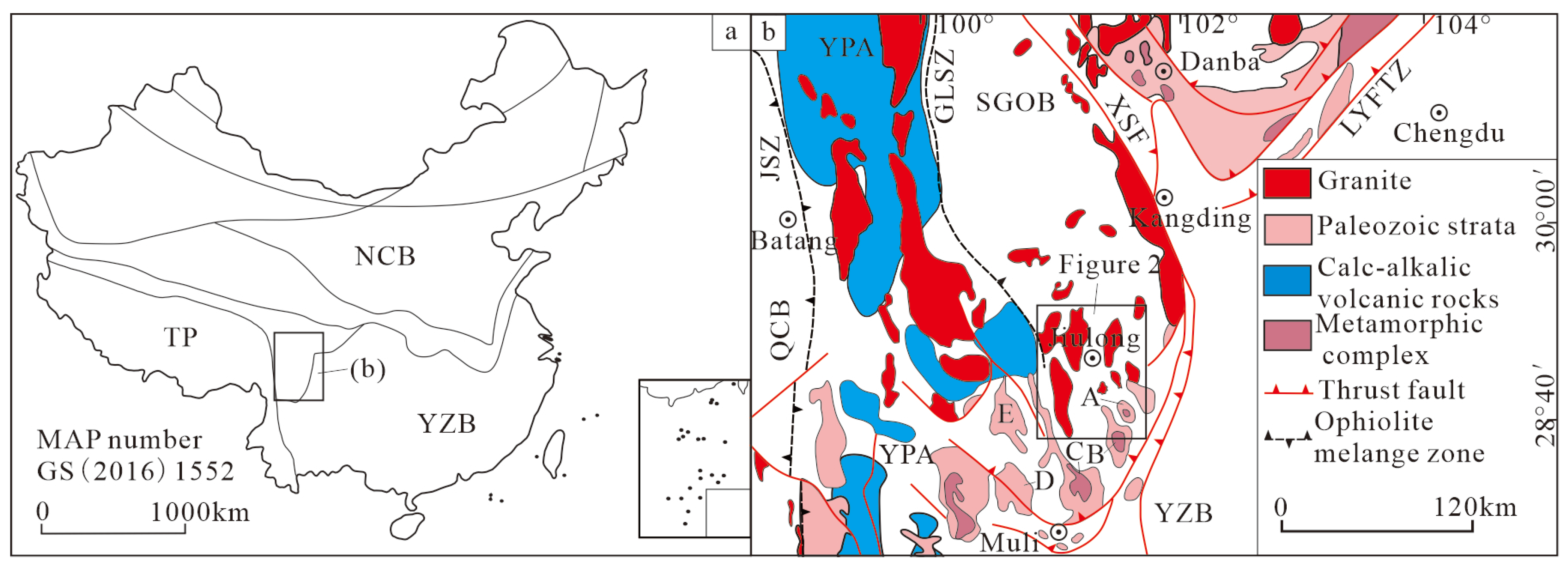


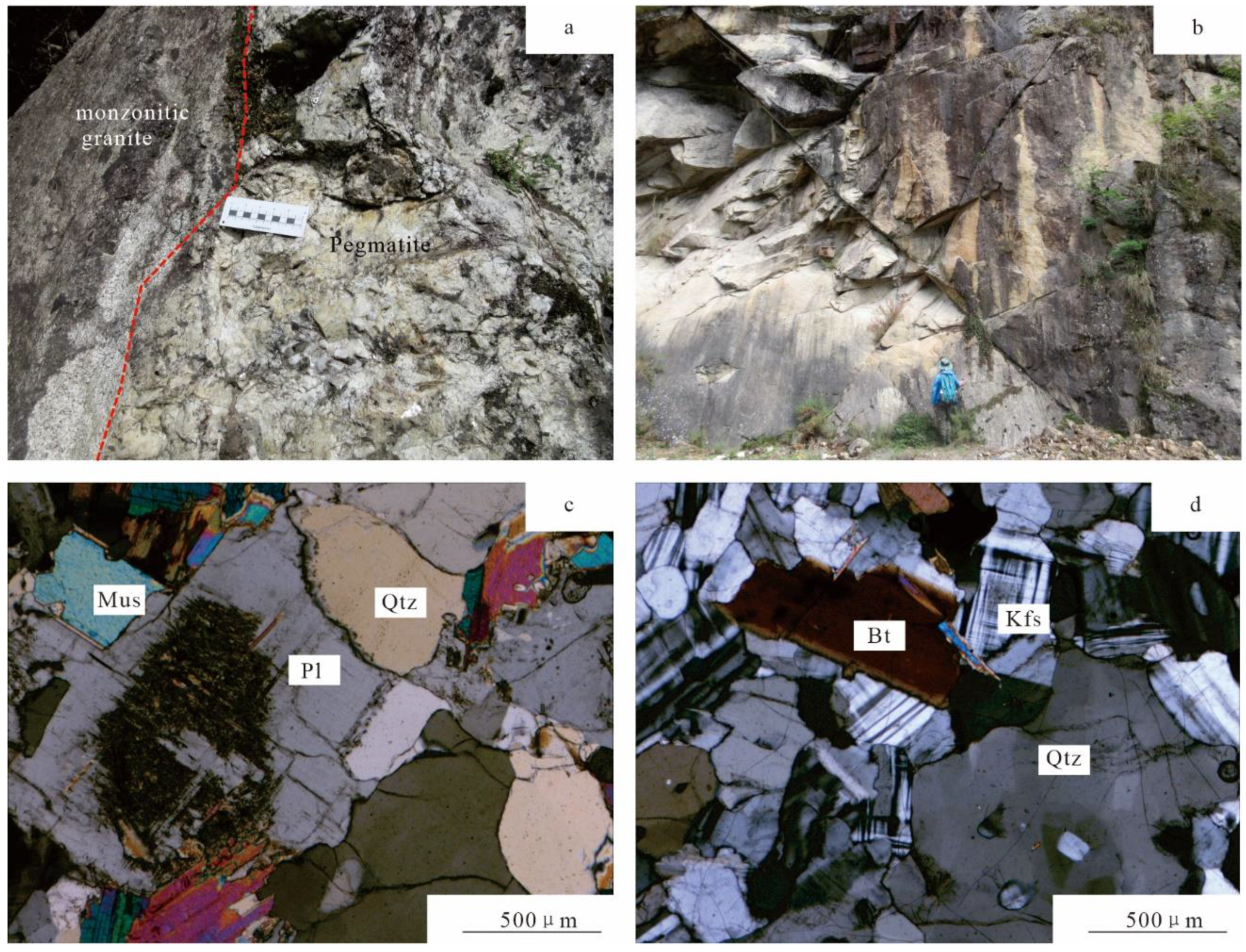
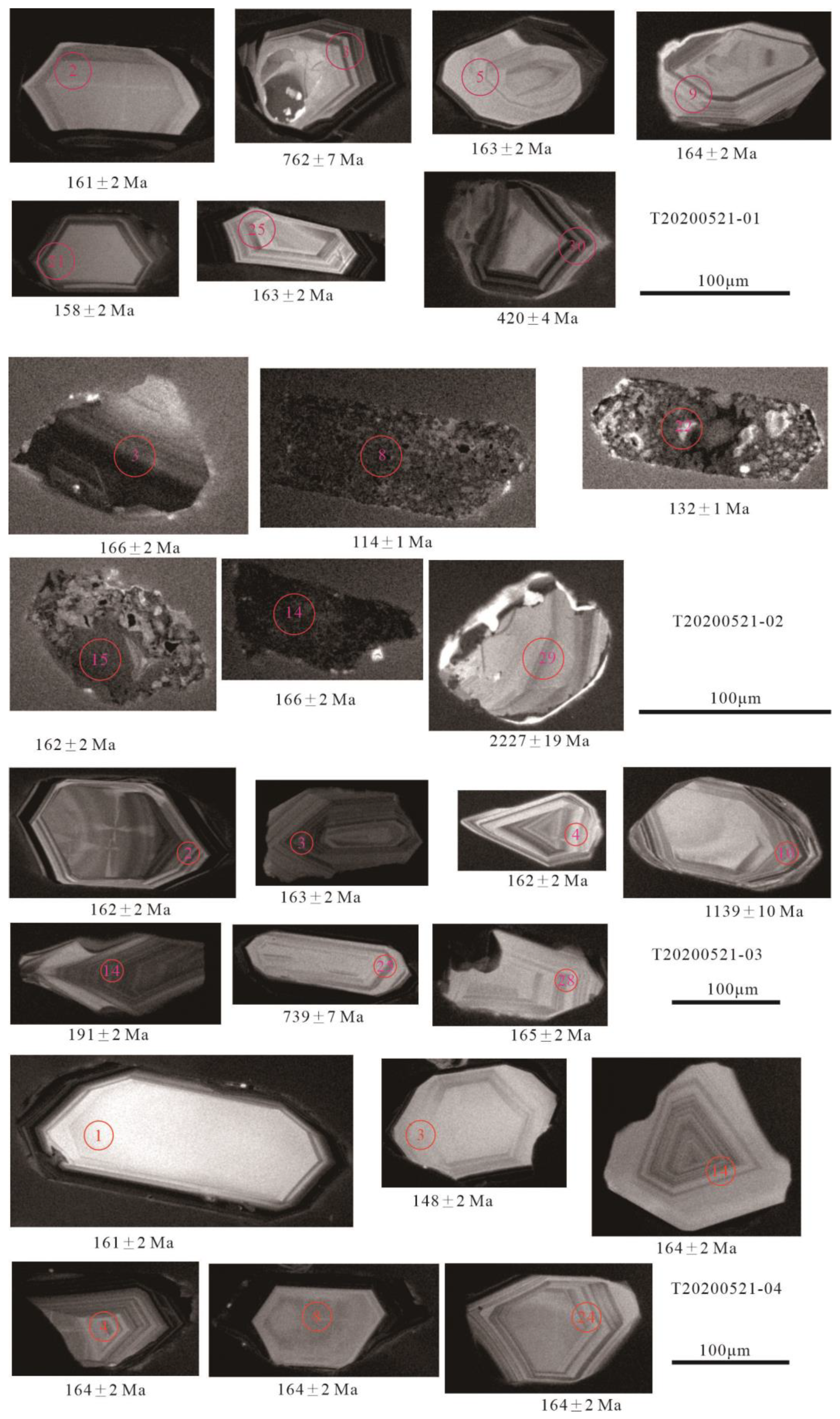
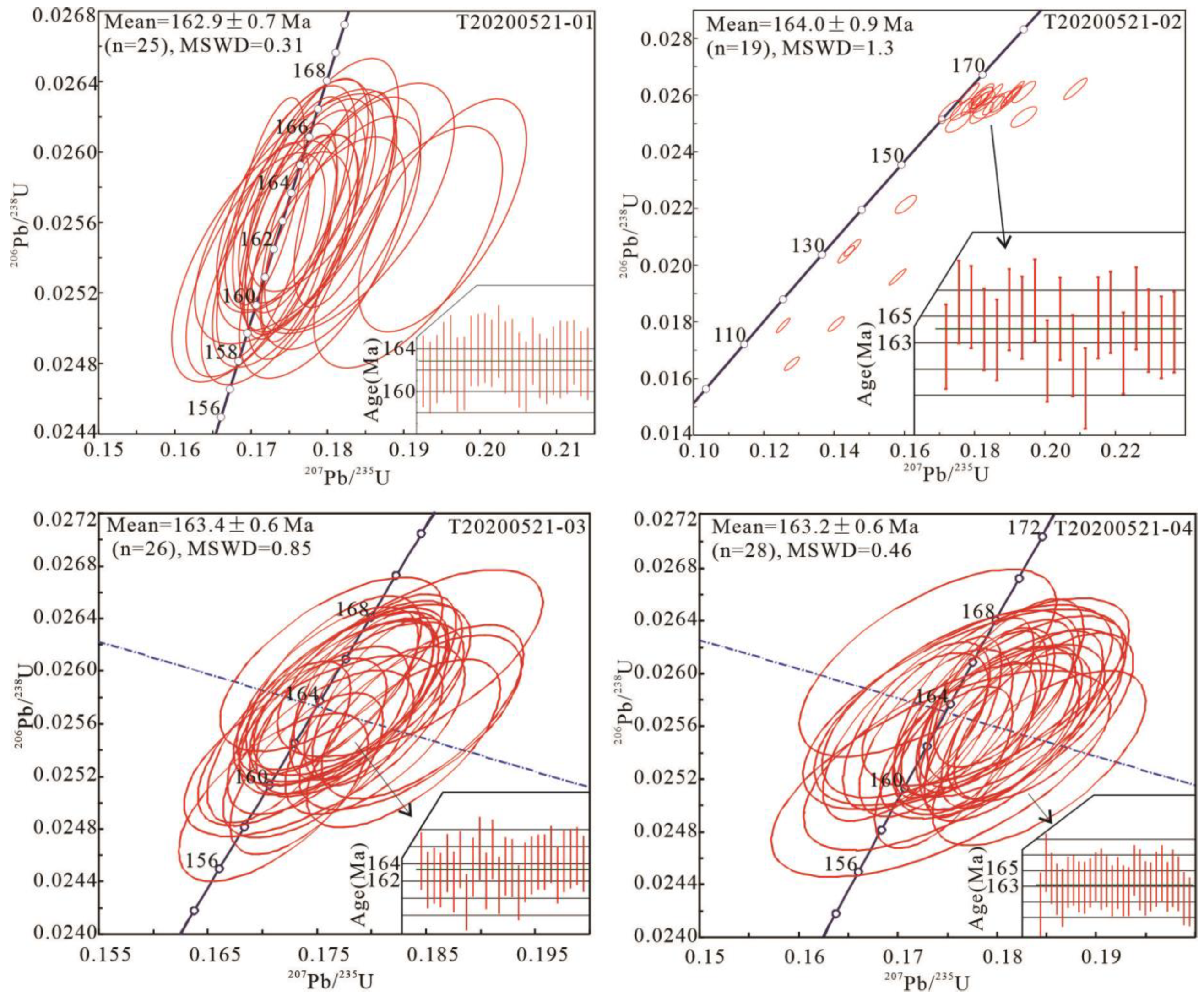
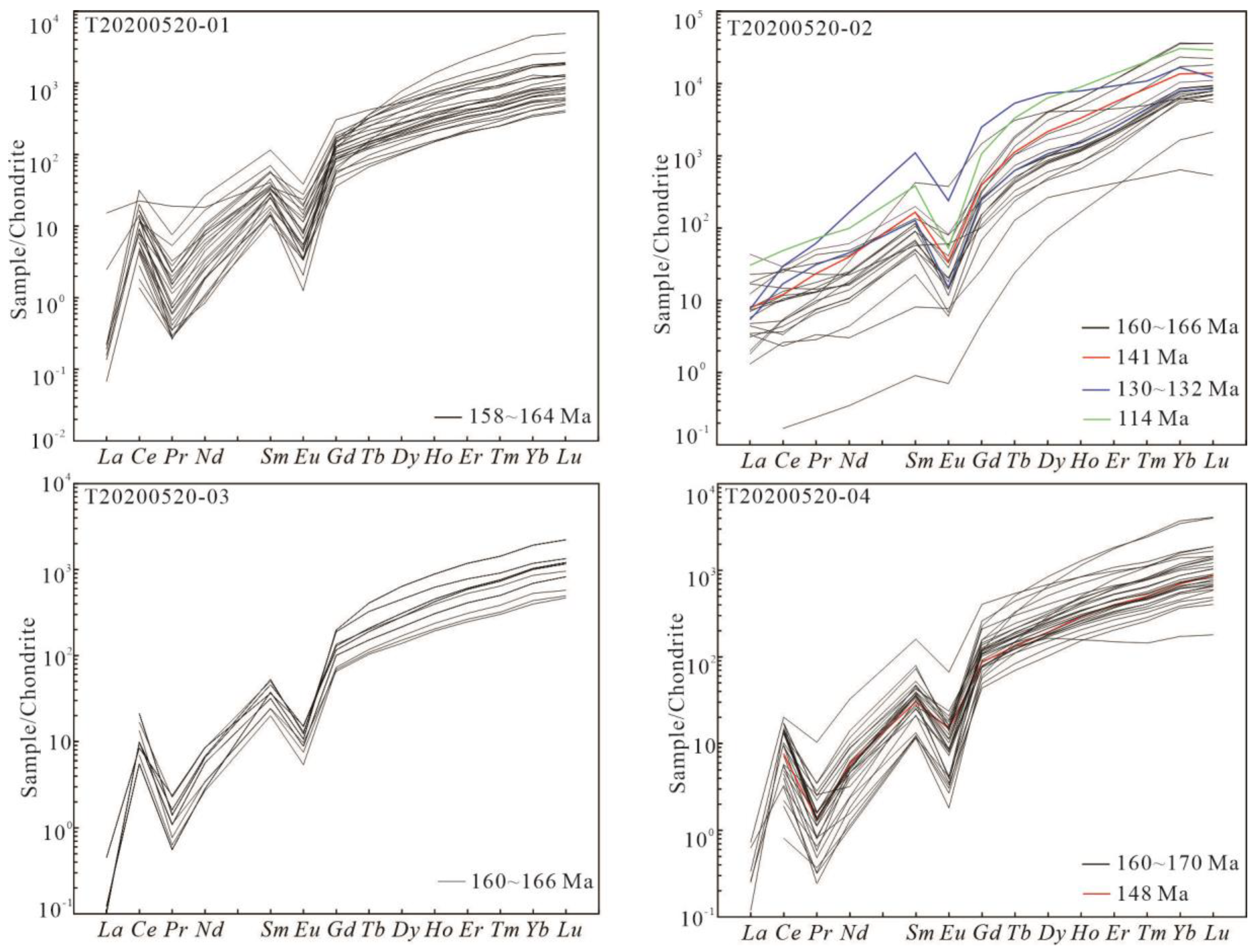

| No. | Unit | Location | Rock | Mineral | Method | Genetic Type | Age (Ma) | Reference |
|---|---|---|---|---|---|---|---|---|
| 1 | Sanyanlong–Fangmaping Galazi | Sanyanlong–Fangmaping | Biotite monzonitic granite | Zircon | LA-ICP-MS | Adakite | 208 ± 2 | [42] |
| Granodiorite | Zircon | I-type granite | 212 ± 2 | [42] | ||||
| Galazi | Monzonitic granite | Zircon | LA-ICP-MS | I-type granite | 211.5 ± 1.2 | [17] | ||
| Granodiorite | Zircon | LA-ICP-MS | I-type granite | 215.6 ± 1.1 | [17] | |||
| 2 | Dingtianzhu | Dingtianzhu | Quartz monzonite | Zircon | LA-ICP-MS | I-type granite | 228 ± 4 | [10] |
| 3 | Riluku | porphyritic granite | Zircon | LA-ICP-MS | high K adakite | 219 ± 6 | [10] | |
| Biotite monzogranite | Zircon | LA-ICP-MS | 207 ± 1 | [21] | ||||
| Biotite monzogranite | Zircon | LA-ICP-MS | 207 ± 1 | [21] | ||||
| Biotite monzogranite | Zircon | LA-ICP-MS | 206 ± 1 | [21] | ||||
| Biotite monzogranite | Zircon | LA-ICP-MS | 208 ± 1 | [21] | ||||
| Biotite monzogranite | Zircon | LA-ICP-MS | 207 ± 1 | [21] | ||||
| 4 | Lanniba | Lanniba | Biotite Granite | Zircon | LA-ICP-MS | I-type granite | 211.4 ± 1.5 | [42] |
| Muscovite syenite granite | Zircon | LA-ICP-MS | I-type granite | 208.2 ± 1.6 | [38] | |||
| Biotite syenite granite | Zircon | LA-ICP-MS | I-type granite | 173.5 ± 1.3 | [38] | |||
| Monzonitic granite | Zircon | LA-ICP-MS | I-type granite | 208.3 ± 2.2 | [38] | |||
| Granodiorite | Zircon | LA-ICP-MS | I-type granite | 214.6 ± 2.0 | [38] | |||
| Granodiorite | Zircon | LA-ICP-MS | I-type granite | 216.5 ± 1.9 | [38] | |||
| Quartz diorite | Zircon | LA-ICP-MS | I-type granite | 213.3 ± 1.8 | [38] | |||
| 6 | Dichishan | Dichishan | Granite | Zircon | LA-ICP-MS | S-type granite | 201.9 ± 0.8 | [24] |
| Pegmatite | molybdenite | Re-Os | 188.6 ± 4.8 | [24] | ||||
| 7 | Yangfanggou | Yangfanggou | Syenite | Zircon | LA-ICP-MS | I-type granite | 211.4 ± 1.5 | [10] |
| Daqiangou | No. 1 Li-Be orebody | Cassiterite | LA-ICP-MS | 157.7 ± 1.8 | [25] | |||
| Daqiangou | No. 1 Li-Be orebody | Columbite-tantalite | LA-ICP-MS | 162.8 ± 0.5 | [25] | |||
| 8 | Xinhuoshan | Xinhuoshan | Biotite Granite | Zircon | LA-ICP-MS | A-type granite | 161.5 ± 0.6 | [28] |
| Daheibian South | Granite | Zircon | SHRIMP | 176 ± 7 | [27] | |||
| Wenjiaping | Biotite Granite | Zircon | LA-ICP-MS | 164.6 ± 0.9 | [32] | |||
| Xinhuoshan | Biotite Granite | Zircon | LA-ICP-MS | 161.5 ± 0.6 | [28] | |||
| Wenjiaping | Biotite Granite | Zircon | LA-ICP-MS | 160.9 ± 1.0 | [46] | |||
| Wenjiaping | Porphyraceous Granite | Zircon | LA-ICP-MS | 159.0 ± 0.7 | [33] | |||
| Xinhuoshan | Granite | Zircon | LA-ICP-MS | I-type granite | 161.8 ± 1.2 | [36] | ||
| Xinhuoshan | Granite | Zircon | LA-ICP-MS | I-type granite | 161.8 ± 1.7 | [36] | ||
| Xinhuoshan | Granite | Zircon | LA-ICP-MS | I-type granite | 165.2 ± 1.1 | [36] | ||
| Xinhuoshan | Granite | Zircon | LA-ICP-MS | I-type granite | 165.2 ± 1.4 | [36] | ||
| Shimenkan | Granite | Zircon | LA-ICP-MS | 163.3 ± 0.7 | [33] | |||
| 154.5 ± 2.4 | [33] | |||||||
| 147.3 ± 2.3 | [33] | |||||||
| Shimenkan | Granite | Sphene | LA-ICP-MS | 164.0 ± 3.0 | [33] | |||
| Shimenkan | Granite | Sphene | LA-ICP-MS | 172.5 ± 1.9 | [33] | |||
| Shimenkan | Granite | Sphene | LA-ICP-MS | 182.7 ± 2.5 | [33] | |||
| Shimenkan | Granite | Sphene | LA-ICP-MS | 193.3 ± 3.6 | [33] | |||
| Shimenkan | Granite | Sphene | LA-ICP-MS | 203.6 ± 2.9 | [33] | |||
| Xinhuoshan | Granite | Apatite | LA-ICP-MS | 155.0 ± 4.8 | [33] | |||
| 9 | Western and Eastern Jiulong County | Granodiorite | Zircon | LA-ICP-MS | 213 ± 1 | [21] | ||
| Monzonitic granite | Zircon | LA-ICP-MS | 191 ± 1 | [21] | ||||
| 10 | Northern Jiulong County | Monzogabbro | Zircon | LA-ICP-MS | 211 ± 1 217 ± 1 | [21] | ||
| Quartz monzonite | Zircon | LA-ICP-MS | 208 ± 1 | [21] | ||||
| 11 | Wulaxi | Wulaxi | Two-mica granite | Zircon | LA-ICP-MS | A-type granite | 159.3 ± 0.9 | [29] |
| Wulaxi | Two-mica granite | Zircon | SHRIMP | 166.6 ± 1.1 | [44] | |||
| Daniuchang | Tungsten–molybdenum ore | Molybdenite | Re-Os | 168.1 ± 6.4 | [45] | |||
| Wulaxi | Two-mica granite | Zircon | LA-ICP-MS | 159.3 ± 0.9 | [29] | |||
| Daniuchang | Tungsten–molybdenum ore | Molybdenite | Re-Os | 171.4 ± 1.7 | [33] | |||
| Daniuchang | Tungsten–molybdenum ore | Molybdenite | Re-Os | 166.8 ± 1.7 | [34] | |||
| Ziershi | Tungsten–molybdenum ore | Molybdenite | Re-Os | 160.3 ± 1.6 | This paper | |||
| Wulaxi | Granite | Zircon | LA-ICP-MS | 166.0 ± 0.9 | [34] | |||
| Wulaxi | Granite | Zircon | LA-ICP-MS | 158.9 ± 0.7 | [33] | |||
| Wulaxi | Granite | Zircon | LA-ICP-MS | 163.1 ± 1.3 | [33] | |||
| 151.1 ± 1.8 | [33] | |||||||
| Wulaxi | Granite | Apatite | LA-ICP-MS | 152.1 ± 4.6 | [33] | |||
| Wulaxi | Granite | Apatite | LA-ICP-MS | 168.0 ± 4.6 | [33] | |||
| Wulaxi | Granite | Apatite | LA-ICP-MS | 163.3 ± 1.7 | [33] | |||
| Wulaxi | Molybdenite | Re-Os | 163.7 ± 1.9 | [44] | ||||
| Wulaxi | Granite | Zircon | LA-ICP-MS | I-type granite | 168.5 ± 1.1 | [36] | ||
| Wulaxi | Granite | Zircon | LA-ICP-MS | I-type granite | 168.4 ± 1.2 | [36] | ||
| Wulaxi | Granite | Zircon | LA-ICP-MS | I-type granite | 170.1 ± 0.5 | [36] | ||
| Wulaxi | Granite | Zircon | LA-ICP-MS | I-type granite | 170.1 ± 0.6 | [36] | ||
| Wulaxi | Granite | Monazite | LA-ICP-MS | 154.1 ± 0.7 | [33] | |||
| 12 | Northeast of Taka dome | Huajiaoping | Granite | Zircon | LA-ICP-MS | 163.1 ± 1.4 | [37] | |
| Zircon | LA-ICP-MS | 146 ± 3 | [37] | |||||
| 13 | Qiaopengzi | Landiao | Monzonitic granite | Zircon | LA-ICP-MS | 143.5 ± 1.0 | [25] | |
| Monzonitic granite | Zircon | LA-ICP-MS | 157.1 ± 1.6 | [25] | ||||
| Qiaopengzi | Monzonitic granite | Zircon | LA-ICP-MS | 147 ± 2 | [25] | |||
| Monzonitic granite | Zircon | LA-ICP-MS | 168.2 ± 0.9 | [25] | ||||
| Landiao | Monzonitic granite | Monazite | LA-ICP-MS | 154.6 ± 0.6 | [25] | |||
| Landiao | Monzonitic granite | Monazite | LA-ICP-MS | 152.8 ± 0.5 | [25] | |||
| 14 | Baitai | Baitai | Pegmatite | Columbite-tantalite | LA-ICP-MS | 188.9 ± 1.6 | [22] | |
| Biotite monzogranite | Zircon | LA-ICP-MS | 212.6 ± 3.3 | [25] | ||||
| Biotite monzogranite | Zircon | LA-ICP-MS | 213.5 ± 1.7 | [25] | ||||
| Biotite monzogranite | Zircon | LA-ICP-MS | 212.6 ± 1.8 | [25] |
Disclaimer/Publisher’s Note: The statements, opinions and data contained in all publications are solely those of the individual author(s) and contributor(s) and not of MDPI and/or the editor(s). MDPI and/or the editor(s) disclaim responsibility for any injury to people or property resulting from any ideas, methods, instructions or products referred to in the content. |
© 2024 by the authors. Licensee MDPI, Basel, Switzerland. This article is an open access article distributed under the terms and conditions of the Creative Commons Attribution (CC BY) license (https://creativecommons.org/licenses/by/4.0/).
Share and Cite
Yang, S.; Tan, H.; Li, Z.; Hu, J.; Wang, X.; Liu, D. Metallogenic Chronology and Prospecting Indication of Tiechanghe Granite and Polymetallic Molybdenum Mineralization Types in Jiulong Area, Western Sichuan, China. Minerals 2024, 14, 909. https://doi.org/10.3390/min14090909
Yang S, Tan H, Li Z, Hu J, Wang X, Liu D. Metallogenic Chronology and Prospecting Indication of Tiechanghe Granite and Polymetallic Molybdenum Mineralization Types in Jiulong Area, Western Sichuan, China. Minerals. 2024; 14(9):909. https://doi.org/10.3390/min14090909
Chicago/Turabian StyleYang, Shuang, Hongqi Tan, Zhongquan Li, Junliang Hu, Xinyan Wang, and Daming Liu. 2024. "Metallogenic Chronology and Prospecting Indication of Tiechanghe Granite and Polymetallic Molybdenum Mineralization Types in Jiulong Area, Western Sichuan, China" Minerals 14, no. 9: 909. https://doi.org/10.3390/min14090909






